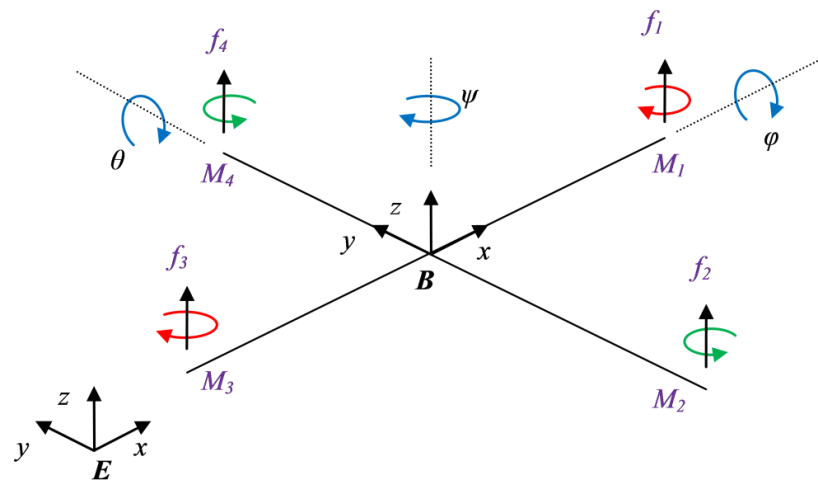Robust LPV Control for Attitude Stabilization of a Quadrotor Helicopter under Input Saturations
DOI:
https://doi.org/10.46604/aiti.2020.3953Keywords:
quadrotor, LPV systems, optimal weighting functions, cuckoo search, input saturationsAbstract
This article investigates the robust stabilization of the rotational subsystem of a quadrotor against external inputs (disturbances, noises, and parametric uncertainties) by the LFT-based LPV technique. By establishing the LPV attitude model, the LPV robust controller is designed for the system. The weighting functions are computed by Cuckoo Search, a meta-heuristic optimization algorithm. Besides, the input saturations are also taken into account through the Anti-Windup compensation technique. Simulation results show the robustness of the closed-loop system against disturbances, measurement noises, and the parametric uncertainties.
References
L. Carrillo, A. López, R. Lozano, and C. Pégard, Quad Rotorcraft Control. London: Springer-Verlag, 2013.
N. Vafamand and A. Khayatian, “Model predictive-based reset gain-scheduling dynamic control law for polytopic LPV systems,” ISA Transactions, vol. 81, pp. 132-140, 2018.
H. Behzad, A. Casavola, F. Tedesco, and M. A. Sadrnia, “Use of LPV-LFT unknown input observers for the design of fault tolerant sensor reconciliation schemes,” Proc. Iranian Conference on Electrical Engineering, Mashhad, Iran, May 2018, pp. 899-905.
P. Apkarian and P. Gahinet, “A convex characterization of gain-scheduled H∞ controllers,” IEEE Transactions on Automatic Control, vol. 40, no. 5, pp. 853-864, 1995.
D. McFarlane and K. Glover, Robust Controller Design Using Normalized Coprime Factor Plant Descriptions, vol. 138 of Lecture Notes in Control and Information Sciences, Berlin: Springer-Verlag, 1990.
A. D. Rosaline and S. Ushakumari, “Robust loop-shaping controller for load frequency control of an uncertain deregulated power system,” Journal of the Institution of Engineers (India): Series B, vol. 100, no. 4, pp. 357-369, Auguest 2019.
L. Yu, C. Che, J. Guo, and H. Wang, “The design of H∞ mixed sensitivity controller for fin/tank roll stabilizer,” Proc. 35th Chinese Control Conference, Chengdu, China, July 2016, pp. 2929-2933.
S. Skogestad and I. Postlethwaite, Multivariable feedback control, analysis and design, 2nd ed. Chichester: John Wiley & Sons, 2005.
R. W. Beaven, M. T. Wright, and D. R. Seaward, “Weighting function selection in the H∞ design process,” Control Engineering Practice, vol. 4, no. 5, pp. 625-633, May 1996.
K. Zhou and J. C. Doyle, Essentials of Robust Control, New Jersey: Prentice Hall, 1998.
J. Hu, C. Bohn, and H. R. Hu, “Systematic H∞ weighting function selection and its application to the real-time control of a vertical take-off aircraft,” Control Engineering Practice, vol. 8, no. 3, pp. 241-252, March 2000.
X. S. Yang, Nature-Inspired Optimizations Algorithms, X.S. Yang (ed.). London: Elsevier, pp. 129-139, 2014.
A. L. Do, O. Sename, L. Dugard, and B. Soualmi, “Multi-objective optimization by genetic algorithms in H∞/LPV control of semi-active suspension,” IFAC Proceedings Volumes, vol. 44, no. 1, pp. 7162-7167, January 2011.
V. T. Vu, O. Sename, L. Dugard, and P. Gaspar, “Multi objective H∞ active anti-roll bar control for heavy vehicles,” IFAC PapersOnLine, vol. 50, no. 1, pp. 13802-3807, July 2017.
J. Fu, Y. Lv, and T. Huang, “Distributed anti-windup approach for consensus tracking of second-order multi-agent systems with input saturation,” Systems & Control Letters, vol. 130, pp. 1-6, Auguest 2019.
E. Prempain, M. C. Turner, and I. Postlethwaite, “Coprime factor based anti-windup synthesis for parameter-dependent systems,” Systems & Control Letters, vol. 58, no. 12, pp. 810-817, December 2009.
S. Hasseni and L. Abdou, “Robust attitude stabilization of a quadrotor by using LFT Linear-Parameter-Varying H∞,” Proc. 26th Mediterranean Conference on Control and Automation, Zadar, Croatia, Auguest 2018, pp. 241-246.
S. Bouabdallah, “Design and control of quadrotors with application to autonomous flying,” Ph.D. thesis, EPFL, Switzerland, 2007.
X. S. Yang and S. Deb, “Cuckoo search via Lévy flights,” Proc. World Congress on Nature and Biologically Inspired Computing, Coimbatore, India, December 2009, pp. 210-214.
A. Ouaarab, B. Ahiod, and X. S. Yang, “Discrete cuckoo search algorithm for the travelling salesman problem,” Neural Computing and Applications, vol. 24, no. 7-8, pp. 1659-1669, June 2014.
A. Ouaarab, B. Ahiod, and X. S. Yang, “Improved and discrete cuckoo search for solving the travelling salesman problem,” Cuckoo Search and Firefly Algorithm, Theory and Applications, X. S. Yang (ed.). Cham, Switzerland: Springer, 2014, pp. 63-84.
X. S. Yang and S. Deb, “Multiobjective cuckoo search for design optimization,” Computers & Operations Research, vol. 40, no. 6, pp. 1616-1624, June 2013.
B. Liu, M. Hou, and Y. Li, “Field-of-view and impact angle constrained guidance law for missiles with time-varying velocities,” IEEE Access, vol. 7, pp. 61717-61727, May 2019.
M. Li, and C. Liu, “New second order sliding mode control design for course-keeping control of ship with input saturation,” Proc. International Conference on Advanced Mechatronic Systems, Xiamen, China, March 2018, pp. 462-466.
P. F. Weston and I. Postlethwaite, “Linear conditioning for systems containing suturing actuators,” Automatica, vol. 36, no. 9, pp. 1347-1354, September 2000.
M. C. Turner, G. Herrmann, and I. Postlethwaite, “Incorporating robustness requirements into antiwindup design,” IEEE Transactions on Automatic Control, vol. 52, no. 10, pp. 1842-1855, 2007.

Published
How to Cite
Issue
Section
License
Submission of a manuscript implies: that the work described has not been published before that it is not under consideration for publication elsewhere; that if and when the manuscript is accepted for publication. Authors can retain copyright in their articles with no restrictions. is accepted for publication. Authors can retain copyright of their article with no restrictions.
Since Jan. 01, 2019, AITI will publish new articles with Creative Commons Attribution Non-Commercial License, under The Creative Commons Attribution Non-Commercial 4.0 International (CC BY-NC 4.0) License.
The Creative Commons Attribution Non-Commercial (CC-BY-NC) License permits use, distribution and reproduction in any medium, provided the original work is properly cited and is not used for commercial purposes.







